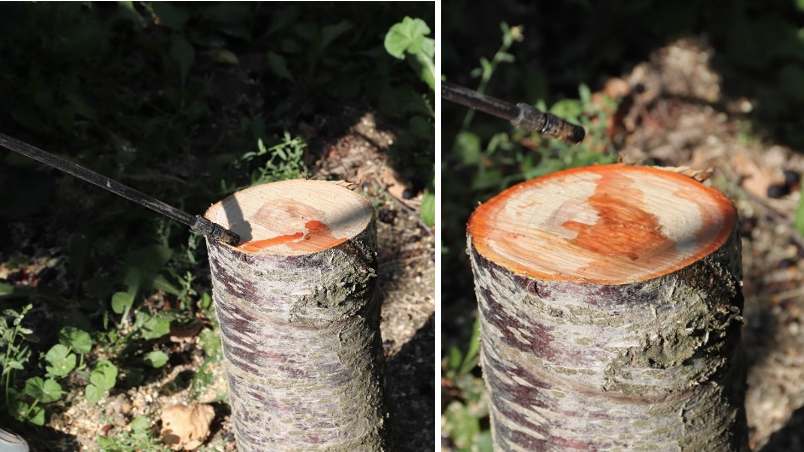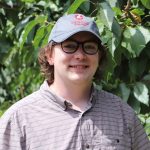Written by Cody Molnar, WSU Extension ITT Coordinator for Little Cherry; October 8, 2020.
Removing trees infected with X-disease phytoplasma and Little cherry virus is critical to stop the spread of the pathogens. Here are case studies four to seven in our tree removal case studies series. To see the first three case studies go to https://treefruit.wsu.edu/article/tree-removal-case-studies/. Little herbicide injury to root grafted trees was seen in rootstocks other than Mazzard. Late summer seems to be a good time to treat and remove infected trees.
General recommendations for tree removal include: 1) apply insecticide before tree removal to limit spread; 2) remove infected trees; 3) apply glyphosate via cut stump or frill to identify root grafted trees and kill roots or remove as many roots as possible and test adjoining trees; 4) if more than 20% of the block is infected consider whole block removal. Timely removal of infected trees which are the source of spread is most important.
Case Study 4
In Zillah, a block of Santina on Gisela 12 (approximately 11 in circumference) was used to conduct a case study trial in herbicide application methods. On August 6th, trees were treated with either a) 20 mL of 100% glyphosate applied directly to the stump (0.06 oz/in; 0.7ml/cm circumference), b) a frill application of 4 mL of 50:50 glyphosate:water applied to 2” deep holes every 3” (0.06 oz/in; 0.7ml/cm circumference), or c) no-herbicide cut stump. Five replicates of each treatment were applied. No adjacent trees showed signs of herbicide injury at two or four weeks post-treatment. At four weeks post-treatment, root death was evaluated for 15 roots per tree on a 1-7 scale where roots rated over 5 were considered dead. Direct application resulted in 31% root death, while the diluted injection treatment resulted in 48% root death. No root injury or death was seen on trees that did not receive herbicide treatments.
Case Study 5
Mike Van Horn removed several infected Rainier on Mazzard trees (approx. 35 in circumference) during the last week of July. Van horn stumped trees, scored the stump with a chain saw then applied approx. 3 oz of 100% glyphosate per tree (0.1 oz/in; 1 ml/cm circumference) (Figure 1). No adjoining trees showed glyphosate injury after two weeks. After four weeks 2 of 9 neighboring trees showed herbicide injury indicating root grafting. One root-grafted tree was over 20 feet away from the treated stump. 80% of roots from stumped trees had root death over 5 on a 1 to 7 scale when evaluated four weeks after herbicide application. Van horn feels being proactive and aggressive in tree removal and leafhopper sprays will help manage the disease and limit the spread to other blocks. To limit the potential for re-infection, he does not plan to replant the block soon.

Case Study 6
In early August several 10-15” circumference Rainier on Giesla 6 and Krymsk® 6 trees were removed due to X-disease infections. The grower stumped trees and applied a concentration of 100% glyphosate at approx. 2 ml per inch of tree diameter (0.07 oz/in; 0.8ml/cm diameter) with a sprayer to the cambium around the edge of the stump (Figure 2). At two and four weeks post-treatment, adjoining trees showed no signs of herbicide injury (Figure 3). The grower has seen herbicide injury in adjoining using the same method in other trees with Mazzard rootstock. Evaluation of 15 roots per tree showed 38% root death (ratings over 5 on a 1 to 7 scale) of treated trees.


Case Study 7
Jim Doornink removed several trees with symptoms of X-disease. In mid-July his team made a notch with a chainsaw for every 3 in of tree diameter (four to twelve per tree) and applied approx. 5 ml of 100% glyphosate per notch (0.06 oz/in; 0.7ml/cm tree diameter) (Figure 4). By early August, herbicide injury to treated trees was evident. If some leaders survived the initial treatment, the process was repeated until the entire tree appeared dead (Figure 5). Doornink actively sprayed for leafhoppers during this process to help reduce pathogen spread. No adjoining trees showed herbicide injury when assessed two and four weeks after application. Examination of 15 roots per tree four weeks after the final herbicide application showed 100% of large roots and 98% small roots where roots were considered dead when rated ≥5 on a 1 to 7 scale.


Additional Information
- Case studies on tree removal for X-disease phytoplasma and Little cherry virus (Part 1) https://treefruit.wsu.edu/article/tree-removal-case-studies/
- BMPs for tree removal for X disease and Little Cherry Virus infected trees https://treefruit.wsu.edu/article/bmps-for-tree-removal-for-x-disease-and-little-cherry-virus-infected-trees/
- X-disease phytoplasma (Western X)
https://treefruit.wsu.edu/crop-protection/disease-management/western-x/
Contacts
 Cody Molnar, WSU Extension ITT Coordinator for Little Cherry (509) 574-1595 cody.molnar@wsu.edu
Cody Molnar, WSU Extension ITT Coordinator for Little Cherry (509) 574-1595 cody.molnar@wsu.edu
Tianna DuPont, WSU Extension (509) 293-8758 tianna.dupont@wsu.edu
Bernardita Sallato, WSU Extension (509) 439-8542 b.sallato@wsu.edu
Ashley Thomson, OSU Extension (541) 296-5494 Ashley.Thompson@oregonstate.edu
Karen Lewis, WSU Extension (509) 760-2263 kmlewis@wsu.edu
Use pesticides with care. Apply them only to plants, animals, or sites listed on the labels. When mixing and applying pesticides, follow all label precautions to protect yourself and others around you. It is a violation of the law to disregard label directions. If pesticides are spilled on skin or clothing, remove clothing and wash skin thoroughly. Store pesticides in their original containers and keep them out of the reach of children, pets, and livestock.
YOU ARE REQUIRED BY LAW TO FOLLOW THE LABEL. It is a legal document. Always read the label before using any pesticide. You, the grower, are responsible for safe pesticide use. Trade (brand) names are provided for your reference only. No discrimination is intended, and other pesticides with the same active ingredient may be suitable. No endorsement is implied.
treefruit.wsu.edu articles may only be republished with prior author permission © Washington State University. Republished articles with permission must include: “Originally published by Washington State Tree Fruit Extension at treefruit.wsu.edu” along with author(s) name, and a link to the original article.
